The ocean life is full of surprises. Some of them are mostly speedy, and some of them are very slow. When it comes to the slowest sea animals, there are many to share. Here I will discuss 20 of the slowest sea animals on our planet.
From giant sea turtles to graceful manatees, these creatures have adapted to their environment to become some of nature’s most interesting and unique species. I’ll also take a look at why they move so slowly and what makes them different from other aquatic life forms.
So grab a cup of tea and get ready to learn about some fascinatingly slow swimmers. But, before you know the details, here is a quick view of all my listed slowest sea creatures. Have a look.
| Sea Animals Name | Interesting Fact |
| Barnacle | They have the largest penis-to-body ratio in the animal kingdom. |
| Blue Whale | They are the largest animal on Earth, even larger than the largest dinosaur. |
| Clam | While some clams live for only a year, there are clams that have been known to live for over 500 years. |
| Coral | They are actually made up of tiny animals called polyps. |
| Crab | They can regenerate their claws if they lose them in a fight. |
| Greenland Shark | They can live for more than 400 years. |
| Limpet | They have a strong foot that allows them to attach themselves to rocks in strong waves. |
| Lobster | Their blood becomes blue when it comes in contact with oxygen. |
| Manatee | They are also known as sea cows and are herbivores. |
| Oyster | They can change their gender multiple times during their lifespan. |
| Sand Dollar | They are not actually related to the type of dollar currency. |
| Sea Anemone | They have venomous tentacles that they use to catch their prey. |
| Sea Cucumber | They have the ability to eject their internal organs as a defense mechanism. |
| Sea Horse | The male sea horse carries the eggs in a pouch until they hatch. |
| Sea Pen | They are colonial animals that live in groups. |
| Sea Slug | They come in a variety of bright colors and have the ability to photosynthesize. |
| Sea Sponge | They are one of the oldest animals in the world, dating back more than 800 million years. |
| Sea Turtle | They can hold their breath for around 2 hours underwater. |
| Sea Urchin | They have a hard outer shell called a test that protects them. |
| Starfish | They have the ability to regenerate their limbs if they lose them. |
20 Slowest Sea Animals: Explained In Detail
Barnacle
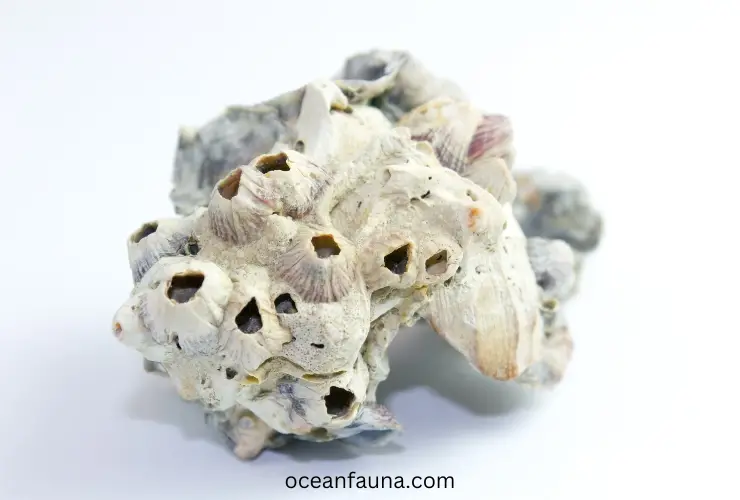
The barnacle (Cirripedia) is a slow-moving creature. These sessile crustaceans are primarily filter feeders, and their sluggish movements are an adaptation to their sedentary lifestyle.
While adult barnacles are stationary, they do move during their larval stage, when they are known as cyprids. These small, six-legged creatures measure just a few millimeters in length and can crawl using a series of hairs located on their legs. However, this movement is relatively slow, averaging around 1.4 cm per second.
There are several reasons why barnacles move slowly. As filter feeders, they do not need to travel large distances to obtain food, as they simply remain in one location and wait for passing water to bring in nutrients.
Also, their hard, calcareous exterior makes movement challenging, requiring significant energy to displace their shell.
Moreover, barnacles are not built for speed. Their bodies are flat and relatively immobile, and they lack the physical adaptations that allow other creatures, such as fish or squid, to move quickly through the water.
Despite their slow movements, barnacles are highly successful and can be found in great numbers throughout the ocean. Their ability to filter feed allows them to extract nutrients efficiently from the water, and their hard, protective shells provide them with excellent defense against predators.
Blue Whale
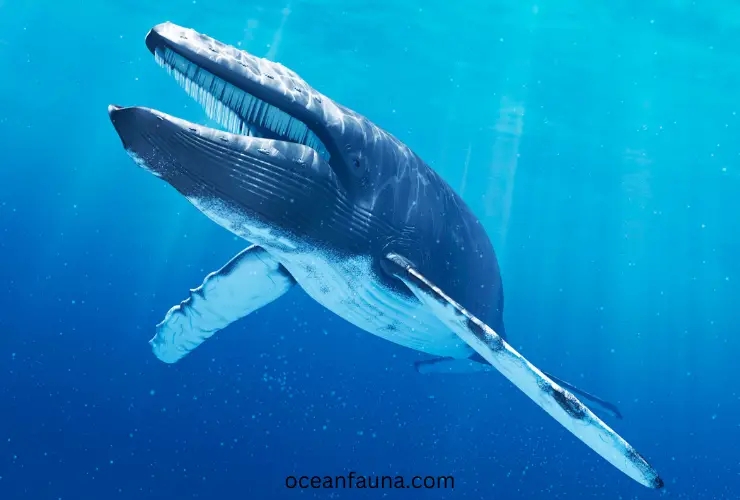
The Blue Whale, also known as Balaenoptera musculus, is the largest animal on the planet, spanning up to 100 feet in length and weighing as much as 200 tons. Despite their impressive size, these magnificent creatures are typically slow-moving, swimming at a leisurely pace of about 5 miles per hour when they are feeding or traveling.
One of the key reasons for the Blue Whale’s slow movement is its immense size. As the largest animal on the planet, they require significant energy to move, and their massive bodies create a lot of drag in the water.
Additionally, their long, slender bodies are not particularly streamlined, which further slows their movement through the water.
Despite their sluggish pace, Blue Whales are capable of remarkable bursts of speed when the need arises. When they are fleeing from danger or pursuing prey, they can accelerate to over 20 miles per hour, using their powerful, paddle-like flippers to propel themselves through the water. However, these bursts of speed are short-lived, and the Blue Whale quickly returns to its more sedate pace.
Clam
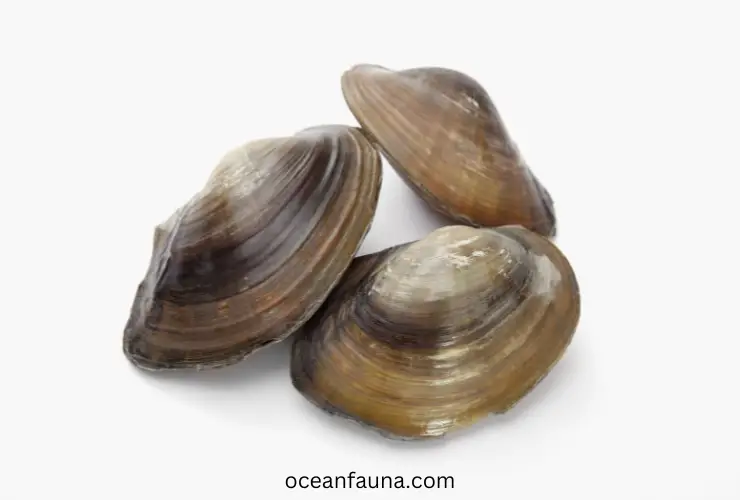
Clams, belonging to the Bivalvia class of mollusks, are sluggish creatures mostly found in the ocean. They are slow-moving due to several reasons, one of which is their feeding mechanism.
Clams are also filter feeders, meaning they extract their food from the surrounding water by filtering out particles smaller than their gills. In order to achieve this, they must remain stationary and keep their shells open. This makes them vulnerable to predators and limits their mobility.
Moreover, the anatomy of clams plays a big role in their slow movement. As mentioned earlier, their main mode of movement is achieved through the quick retraction of their foot, which then propels them through the water by creating a jet of water that propels them forward.
However, this movement is limited in scope, as clams can only travel small distances before they become exhausted. Also, their shells are heavy and cumbersome, further restricting their mobility.
Another reason why clams are slow-moving is their reproductive behavior. Clams typically reproduce through external fertilization, which means a female clam releases her eggs into the water, and a male clam releases his sperm.
Coral
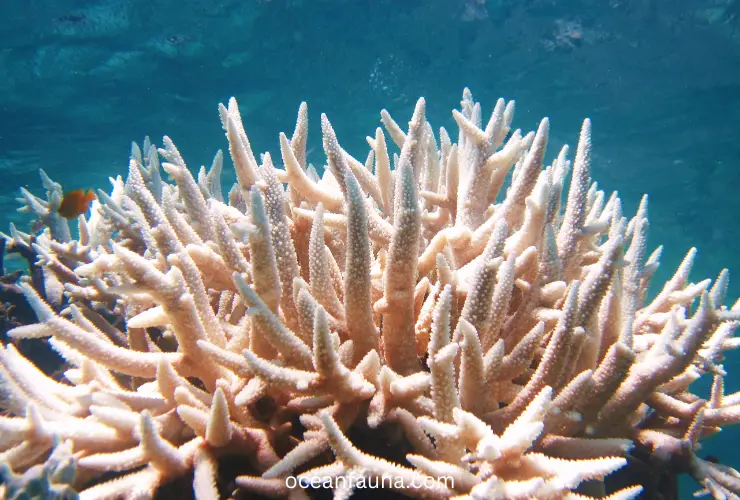
Coral (Anthozoa) is a fascinating creature that inhabits the ocean floor. Despite their beauty and vibrant colors, they are essentially stationary creatures that cannot move themselves. Rather, they are firmly anchored to a substrate, such as rocks or the ocean floor, and grow in colonies.
These sessile organisms are incredibly diverse, with over 10,000 known species ranging from soft, delicate shapes to bold and massive structures that form extensive reefs or barriers. They come in various colors, from bright neons to muted pastels, and play vital ecological roles in their habitats.
They also serve as important indicators of environmental change, as they are sensitive to fluctuations in water temperature, acidity, and pollution.
Coral is often thought of as slow creature, but they are much more than meets the eye. In fact, these fascinating organisms have a complex structure that enables them to thrive in their particular environments.
Despite their inability to move, coral is constantly growing and evolving. Colonies can expand slowly over time, adding new polyps and intricate structures that create a unique and beautiful ecosystem.
Crab
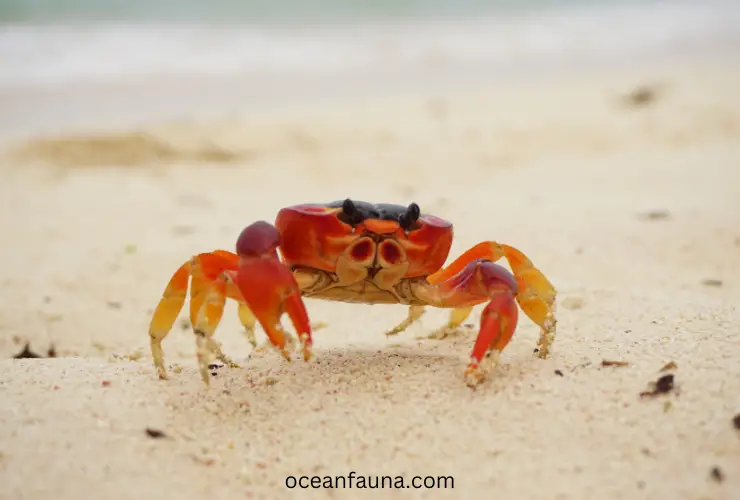
The crab, belonging to the Brachyura species, is a slow-moving ocean creature that can reach speeds of up to 1 meter per second. These fascinating creatures have a hard exoskeleton that protects their tender bodies from predators.
Crabs come in different colors, such as green, brown, and red, and can range in size from a few centimeters to over a meter wide.
Crabs move in a unique way, using their legs to propel themselves forward. Their bodies are flattened, and they have a pair of claws that they use for catching their prey and for self-defense. These creatures are known for their excellent ability to adapt to their environment, which includes the vast ocean, underground burrows, and even trees.
Crabs have a wide range of food sources, which include small fish, crustaceans, algae, and plankton. They possess a robust digestive system that can effortlessly dismantle hard materials like shells and exoskeletons. In case of food scarcity, certain species of crabs may even resort to consuming other crabs.
Crabs may move slowly, but they are very intelligent creatures. They have a sophisticated social hierarchy and use chemical signals and audible clicks to communicate. Furthermore, crabs possess an advanced sense of smell that aids them in finding food and potential mates.
Greenland Shark
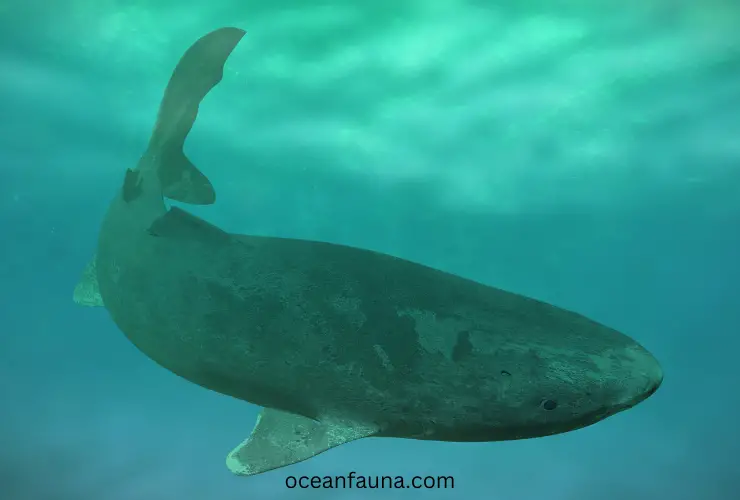
The Greenland shark, also known as Somniosus microcephalus, is the slowest shark specie. These sharks are typically sluggish swimmers, with a speed of less than 3 km (about 1.9 miles) per hour.
One of the defining characteristics of this species is its longevity, with some individuals living to be over 400 years old. They have a robust build, with thick, grey-brown skin that is covered in rough, tooth-like scales called dermal denticles.
Greenland sharks are found in the icy waters of the North Atlantic and Arctic Oceans, primarily around Greenland and Canada. These predators have a varied diet, feeding on fish, crabs, squid, and other invertebrates. They are known for their scavenging habits, often consuming carrion and even garbage from ships.
Greenland sharks may be slow, but they have a strong bite force that they use to easily crush the shells of their prey. In addition, they use their highly developed sense of smell to locate food in their deep, murky underwater environment.
Limpet
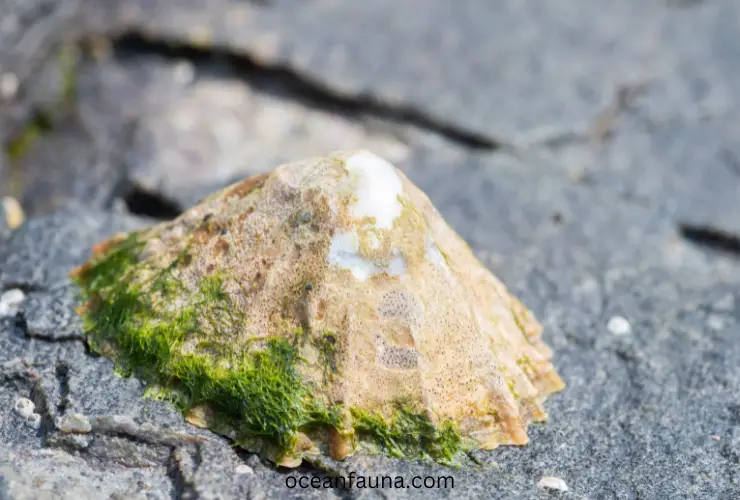
The limpet (Patella vulgata) is a mollusk that is commonly found along rocky shores in the ocean. This creature has a distinctive cone-like shape with a single muscle foot that clings firmly to rocks, allowing it to move around and feed on algae.
Although the limpet might seem sluggish, it can actually move at a relatively high speed, especially during high tides and rough seas. By flexing its muscle foot, the limpet can create suction that helps it cling to surfaces and move easily.
It has been observed that limpets can move at a rate of up to 30 cm per minute, which might not seem fast for humans but is quite impressive for a creature of this size.
Another exciting aspect of the limpet’s speed is that it is influenced by factors such as the texture and angle of the surface it is moving on and the presence of predators.
For instance, when predators like crabs or starfish threaten limpets, they can move more quickly to avoid being caught. This adaptive behavior helps them survive in their harsh environment, where they are at risk of being preyed upon by various predators.
Lobster

The lobster, a member of the Nephropidae family, is a slow-moving creature typically found on the ocean floor. These crustaceans range in size from 25-50 cm in length and rely on their eight legs to slowly walk along the sea bed in search of food.
Although they may move slowly, lobsters can reach remarkable speeds when they need to. They can swiftly move backward through the water by curling and uncurling their abdomens. In fact, they have been observed swimming at speeds of up to 5 m/s (11 mph).
Lobsters are highly adaptable to their environments and can be found in a variety of habitats, from rocky shores to muddy sea floors. They can also survive extreme temperatures, from the frigid waters of the Arctic to the warmer waters found closer to the equator.
Manatee
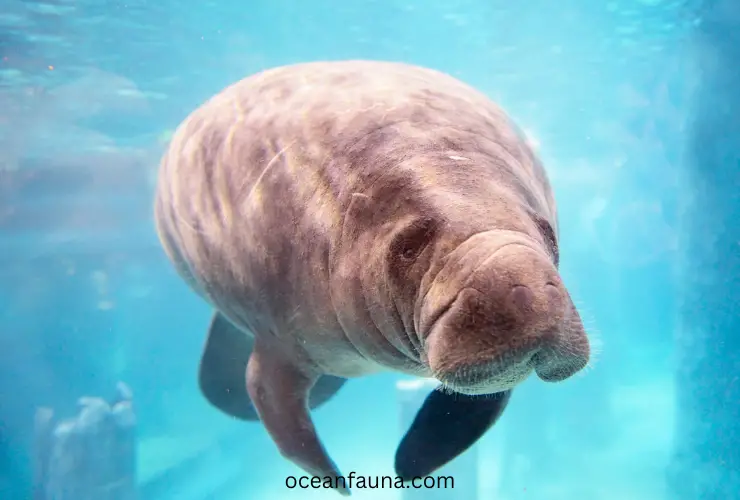
The manatee, scientifically known as Trichechus, is a slow-moving ocean creature that typically putters along at a leisurely pace of three to five miles per hour. Although the manatee can swim up to 20 miles per hour in short bursts, these instances are rare and short-lived.
The manatee is a herbivorous mammal that belongs to the order Sirenia. Their paddle-like flippers and broad, flat tails make them excellent swimmers, albeit at a slow pace.
Manatees are at risk of being attacked by predators like crocodiles, sharks, and killer whales because they move slowly. But their thick skin and blubber provide some protection. Furthermore, they can hold their breath for up to 20 minutes to hide in underwater vegetation or crevices and avoid being caught by predators.
Manatees may not be speedy, but they are key players in keeping the ocean ecosystem healthy. They have a significant role in preserving seagrass beds, critical habitats for various marine animals. Manatees also contribute to clean water by eating algae, which can be harmful if left to grow unchecked.
Oyster
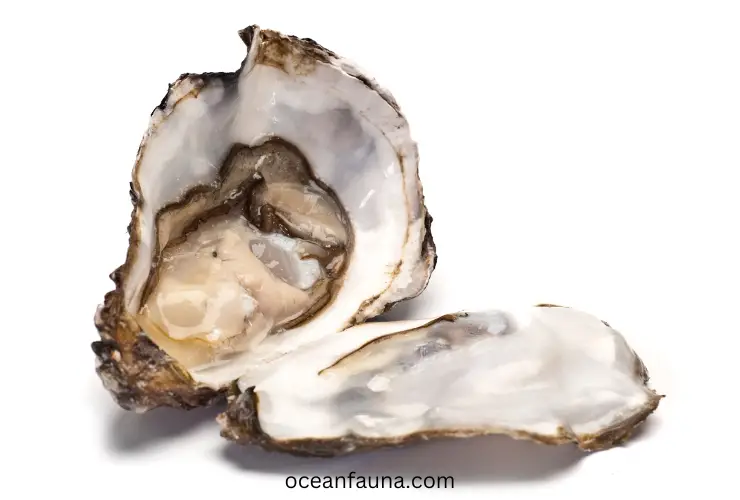
The oyster (Ostreidae) is a bivalve mollusk that dwells in saltwater environments. These slow-moving ocean creatures are known for their hard, irregular-shaped shells that protect them against predators.
Oysters can be found in numerous habitats ranging from shallow reefs to deep-sea beds, and they play a vital role in marine ecosystems as filter feeders. Even though oysters are not very fast, they are unique creatures that have adapted to their slow and stationary lifestyle.
Oysters are particularly interesting because of their special feeding technique: they take in seawater through their gills and filter microscopic food particles out. This feeding style enables them to nourish themselves on a variety of nutrients present in seawater.
The time it takes for an oyster to mature can vary depending on several factors, including temperature, salinity, and food availability. Oysters typically reach maturity within 18 months to 3 years, and during this time, they produce a hard, calcified shell that protects their soft, vulnerable body.
Oysters can move by contracting their adductor muscles, but they move very slowly, which is hardly noticeable to humans. They usually don’t move unless they are forced out of their habitat, and even then, their movement is restricted.
Sand Dollar
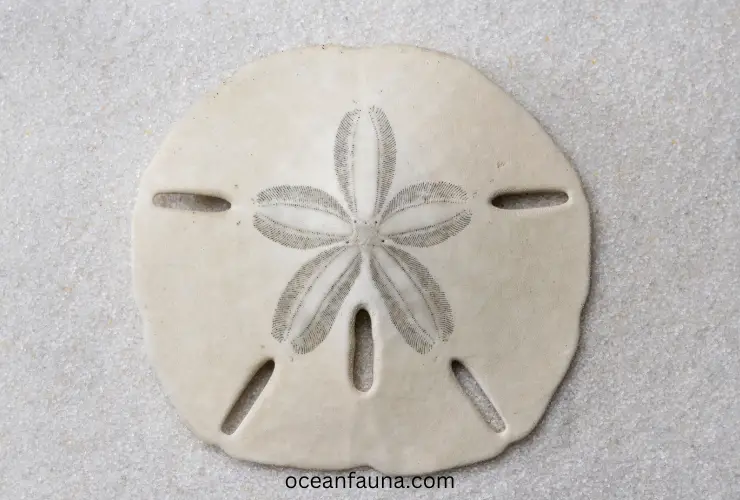
The Sand Dollar, also known as Clypeasteroida, is a fascinating slow-moving creature that inhabits the ocean floor. It is important to note that, unlike other marine animals, Sand Dollars cannot swim due to their flat and rigid body structure.
The Sand Dollar is not a fish but a marine echinoderm related to other creatures such as starfish and sea urchins. It belongs to the class Echinoidea, which is characterized by spiny skin and a five-fold symmetry. The body of the Sand Dollar is round, with a hard shell that is covered in tiny spines.
One interesting fact about Sand Dollars is their feeding habits. They have a unique feeding system known as filter feeding, where they use their spines to filter plankton and detritus from the water. The mouth of the Sand Dollar is located on the bottom side of its shell, and it has a series of tube feet that help with feeding and mobility.
Sand Dollars go through a metamorphosis during their life cycle from a free-swimming larva to a burrowing adult. They can be found in shallow waters along sandy coasts and on the deep ocean floor. Sand Dollars are also highly valued by beachcombers and collectors due to their intricate design and uniqueness.
Sea Anemone
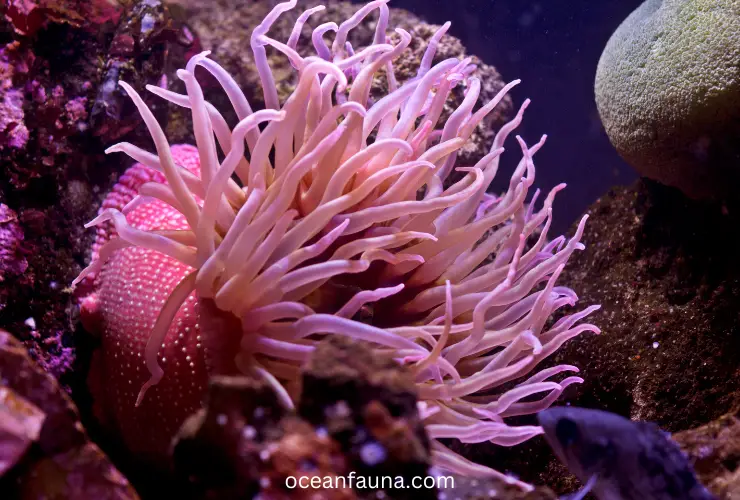
The sea anemone, scientifically known as Actiniaria, is a slow-moving creature found in oceans all over the world. Its movement is unique and interesting. Unlike other sea creatures that use fins or tentacles to propel themselves through the water, the sea anemone does not swim. Instead, it uses its muscular pedal disc to slowly slide across rocks or coral.
This pedal disc is circular in shape and is located at the bottom of the sea anemone. It is covered in small tentacles that help the creature grip onto surfaces.
By contracting and relaxing these muscles, the sea anemone moves along in a gliding motion at a rate of approximately 1 centimeter per hour. This may seem like an incredibly slow speed, but for the sea anemone, it is all the movement they need to get around and find food.
Another fascinating aspect of the sea anemone is its ability to change shape. The sea anemone can retract its tentacles and body when threatened or disturbed, becoming a small, hard ball. This defensive maneuver helps to protect the creature from predators.
In terms of physical appearance, the sea anemone can vary significantly in size and color. Some are less than an inch in diameter, while others can grow up to 3 feet wide. Their tentacles can be short or long, plain or brightly colored, and serve various purposes. Some tentacles are used for catching prey, while others are used for defense or to help the sea anemone move.
Sea Cucumber
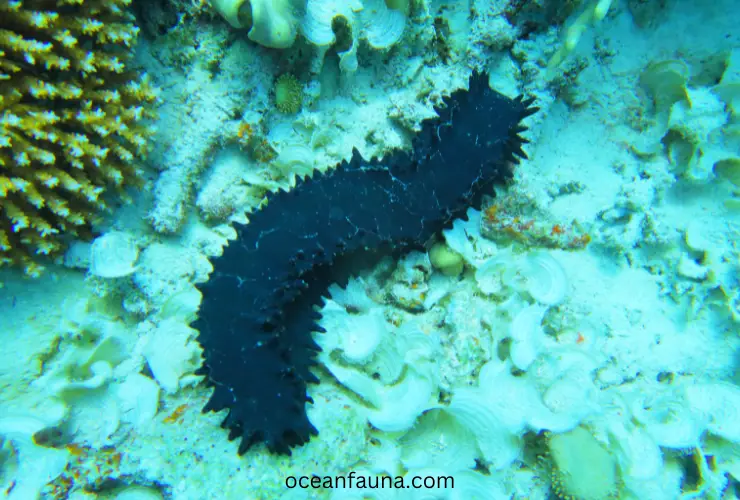
The sea cucumber (Holothuroidea) is a slow-moving, soft-bodied sea creature found in oceans across the world. Its body resembles a cucumber or a sausage.
Sea cucumbers have an interesting feeding mechanism – they use the tentacles surrounding their mouth to collect organic matter and plankton particles from the surrounding water. The processed food is then passed to the digestive system.
Sea cucumbers have different ways of moving – some use their tube feet and move slowly, while others can flex their body and move quickly along the seafloor. They also have the remarkable ability to regenerate lost body parts, which helps them recover from injuries and predators’ attacks.
Sea cucumbers play an essential role in marine ecosystems, as they function to recycle nutrients and help maintain the ocean’s overall health. They also have medicinal properties and have been used in traditional medicine for centuries in Asia.
Sea Horse

The sea horse, also known as the Hippocampus, can be found in shallow seagrass beds in the Western Atlantic Ocean. It is a very slow fish species, with a maximum speed of only 1.5 meters per hour, which makes it widely recognized as the slowest fish in the world.
The seahorse may move slowly, but its distinct appearance sets it apart from other fish. Its body is long and has a unique head resembling a horse. Additionally, seahorses have a tail that they use to anchor themselves in seagrass and catch small prey like shrimp and plankton.
Sea horses are monogamous and form lifelong pair bonds. They engage in an elaborate courtship dance that includes synchronized swimming and intricate color and body posture displays. After mating, the female sea horse deposits her eggs in the male’s brood pouch, fertilizing and nurturing until the young hatch.
The slow movement of the sea horse can be attributed to its unique morphology, as well as its small size. At adult size, the Hippocampus usually measures between 1.5 and 2.5 cm in length. This tiny creature navigates its environment by using small fluttering fins on its back, which propel it forward, and pectoral fins, which steer it.
Sea Pen
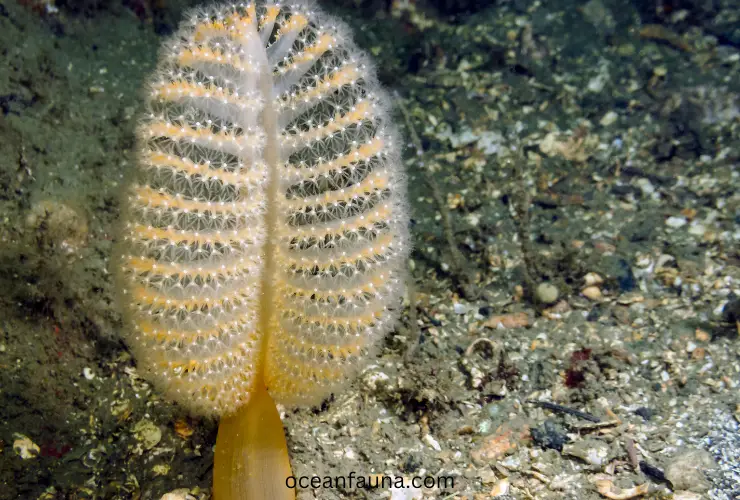
The Sea Pen (Pennatulacea) is a fascinating marine creature that mainly dwells in soft sediment or rocky substrate areas. Unlike other marine organisms, they are immobile and remain anchored to the surface, often appearing as a plant or a pen-like structure that rises from the sea bottom.
The Sea Pen’s shape resembles a quill pen, with a soft and cylindrical body ranging from a few centimeters to several meters in length. It also features a bulbous base that anchors it to the seabed. They come in different colors and patterns, ranging from brown, pink, or white to striped or spotted.
Although they are immobile, they can move their bodies and swim uniquely. They use their rachis, a flexible internal rod, to contract and expand their body like a flickering flame. As they move, water flows around them, propelling them and enabling them to float and drift along with the current.
In addition to their movement, Sea Pens have unique feeding habits. They are filter feeders and use their specialized polyps to capture planktonic organisms and small particles that pass through the water. Through their tentacles, they create a water current that drives the prey into their waiting mouths.
[Exception: Orange Sea Pens can move by inflating their siphonozooids with water and drifting like a leaf in the wind when they need to relocate.]
Sea Slug
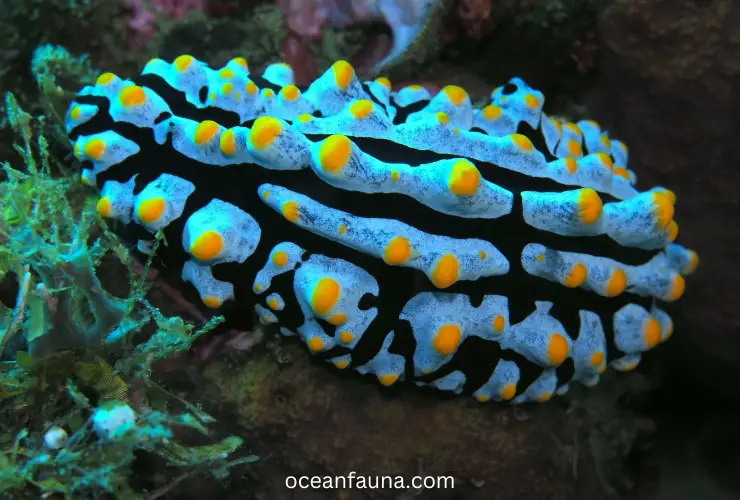
Sea slugs, also known as Nudibranchia, are a fascinating marine gastropod species widely admired for their vibrant coloration and ornate patterns. These creatures are primarily found in warm tropical and temperate waters worldwide.
Unlike other marine creatures that tend to move rapidly through the water, sea slugs are slow-moving creatures that glide gracefully across the ocean floor. They move by flexing their muscular foot, which generates a wave-like motion that propels them forward.
They also use their foot to help them grip onto surfaces, such as rocks or seaweed, to prevent themselves from being swept away by strong currents.
In addition to their unique swimming technique, sea slugs are known for their intricate defense mechanisms. Many species of sea slugs have developed an array of mechanisms to protect themselves from predators.
Some have developed spiny projections that make them less appetizing to predators. Others have evolved a camouflage strategy, mimicking the look of the surrounding plants or animals to blend in and avoid detection. Many species of sea slugs are also toxic and have the ability to release chemicals to deter predators from preying on them.
Sea Sponge
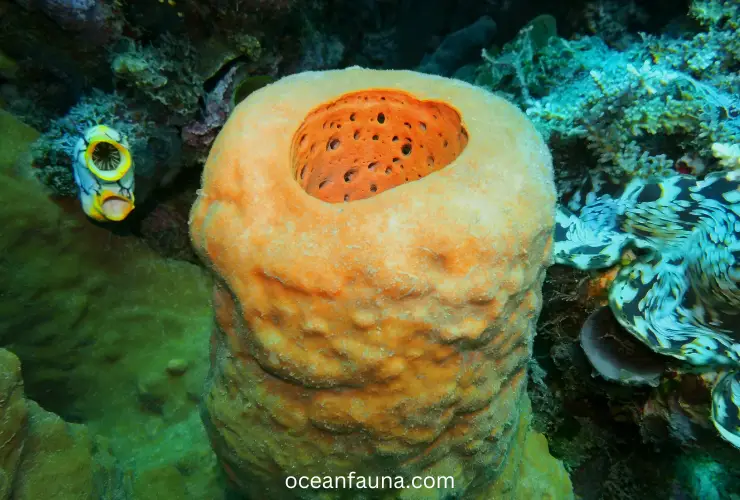
Sea sponges, also known as Porifera, are fascinating ocean creatures that belong to a group of multi-cellular organisms. Despite being sessile animals in their adult form, some marine and freshwater species of sponges can move across the sea bed at surprisingly slow speeds ranging from 1–4 mm (0.039–0.157 in).
Although the movement of these creatures is not exactly akin to swimming, it is more like gliding or creeping along the surface of the sea floor. The movement mechanism in sponges is achieved through the coordinated action of specialized cells called choanocytes that line the insides of the body cavity.
These cells have tiny hair-like structures called flagella that beat rapidly in unison, creating a water current that propels the sponge forward.
Additionally, some sponges are endowed with small bundles of specialized cells called myocytes or pyloric muscles that can contract and relax to alter the shape of the sponge. This mechanism allows the sponge to squeeze through narrow, tight spaces while searching for food or favorable environments.
Moreover, some species of sponges have skeletal elements, either organic or inorganic, that provide structural support. These skeletal elements help the sponge maintain shape and protect against physical stresses such as wave action or predation.
Sea Turtle
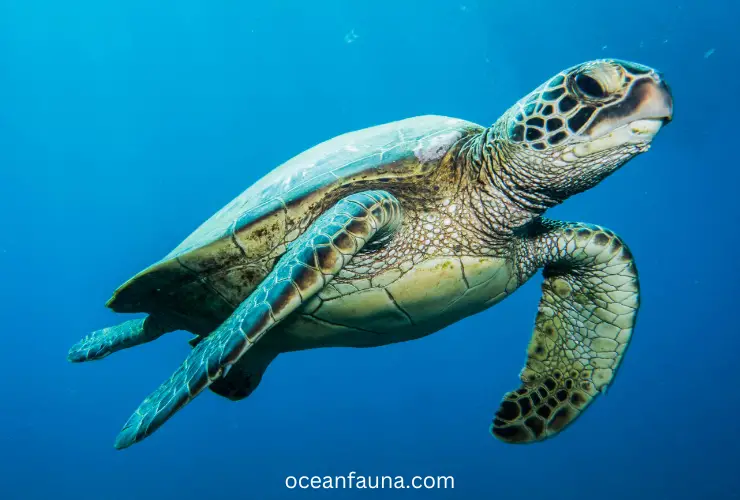
The sea turtle, belonging to the superfamily Chelonioidea, is a fascinating oceanic creature that has been known to exist on Earth for over 150 million years. These slow-moving reptiles can be seen floating gracefully in the ocean waters, gliding through the currents with their powerful flippers.
How sea turtles swim or move is quite unique, as it combines paddling and gliding. The land-dwelling relative of these creatures, the tortoise, moves by walking, while the sea turtle is able to swim using their paddle-like flippers to propel themselves forward through the water.
These appendages are located at the front of the turtle’s shell and can be moved in a forward and backward motion, similar to the way a bird flaps its wings.
The flippers are not the only feature aiding in their swimming capabilities; sea turtles also possess streamlined bodies and have a hydrodynamic shape that allows them to minimize water resistance and maximize swimming efficiency.
Additionally, some species of sea turtles have ridges on their shells that help to channel water along the body, which aids in their movement through ocean currents.
In terms of swimming speed, these creatures are not known for their agility, with top speeds ranging from 2.8 to 10 km/h (1.7 to 6.2 mp/h) depending on the species. However, they can maintain a constant speed over long distances due to their efficient swimming technique.
Sea Urchin
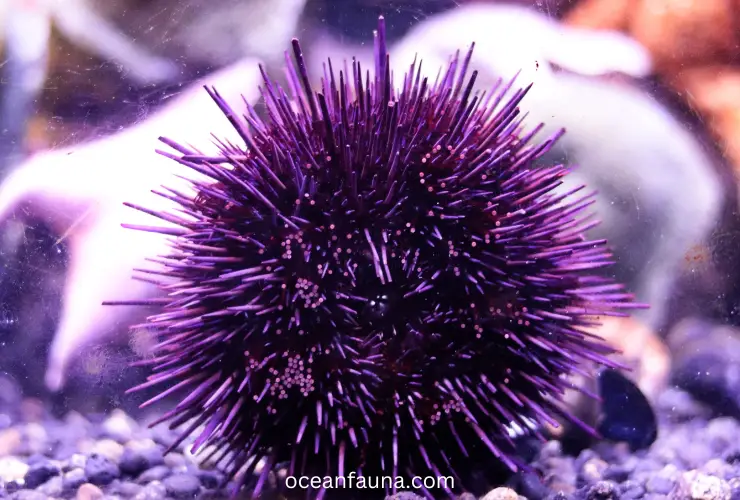
The sea urchin (Echinoidea) is known for its unique mode of propulsion. Sea urchins are well-suited to their underwater habitat and have an essential impact on marine ecosystems, despite moving slowly.
Sea urchins typically move by flexing their long and powerful tube feet, allowing them to swim through the water for short periods. While they may not be the most agile creatures in the sea, their unique method of movement is surprisingly effective.
These tube feet are arranged in five rows along the bottom of the sea urchin’s body and are used for gripping surfaces such as rocks or coral and locomotion. The sea urchin propels itself through the water by contracting these tube feet in a coordinated sequence.
In addition to their tube feet, sea urchins possess an endoskeleton composed of interlocking plates that protect them from predators. These plates are covered in spines that can be used for defense or to help the sea urchin move across rough surfaces.
Starfish
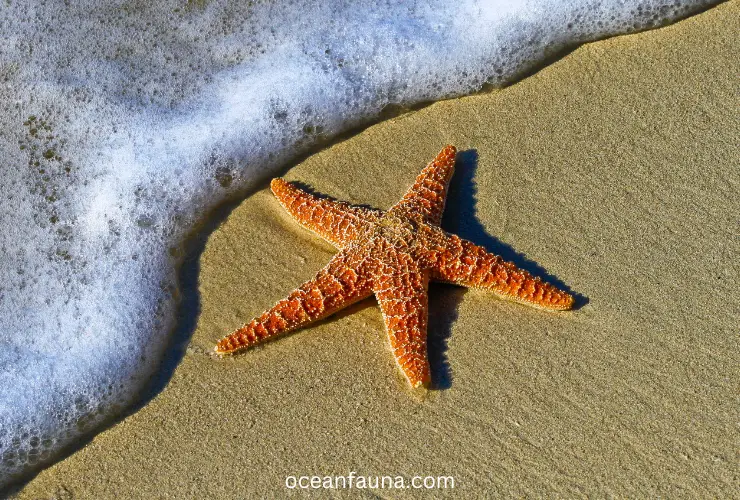
Starfish, scientifically known as Asteroidea, are slow-moving ocean creatures that tend to glide instead of swim. Their unique appearance and movement have captured the interest of ocean enthusiasts worldwide.
Unlike other sea creatures that move by swimming through the water, starfish use a different mechanism to move. They possess hundreds of tiny, suction-like tube feet that line the undersides of their arms.
These tube feet are incredibly flexible and allow starfish to move effortlessly in any direction. They use these tube feet to create a hydraulic pressure that propels them forward, allowing them to crawl across the ocean floor, rocks, and other surfaces.
While starfish may appear to be just gliding along, their tube feet are constantly working, expanding, and contracting to create movement. This unique ability allows starfish to move leisurely, with an average speed of about six inches per minute.
Starfish species vary in their speed and methods of movement. Certain faster species of starfish can crawl up to nine feet per minute, while others have evolved to swim by undulating their arms in a coordinated motion. It is widespread for starfish that inhabit depths greater than 2000 feet to swim instead of crawl.
Conclusion
Now you have a compact knowledge of all the 20 slowest animals. If you want to know more about them, read our other blogs categorically. You may also keep your question in the comment section. I will answer them as soon as possible.


1 thought on “20 Slowest Sea Animals: [Explained With Photo]”